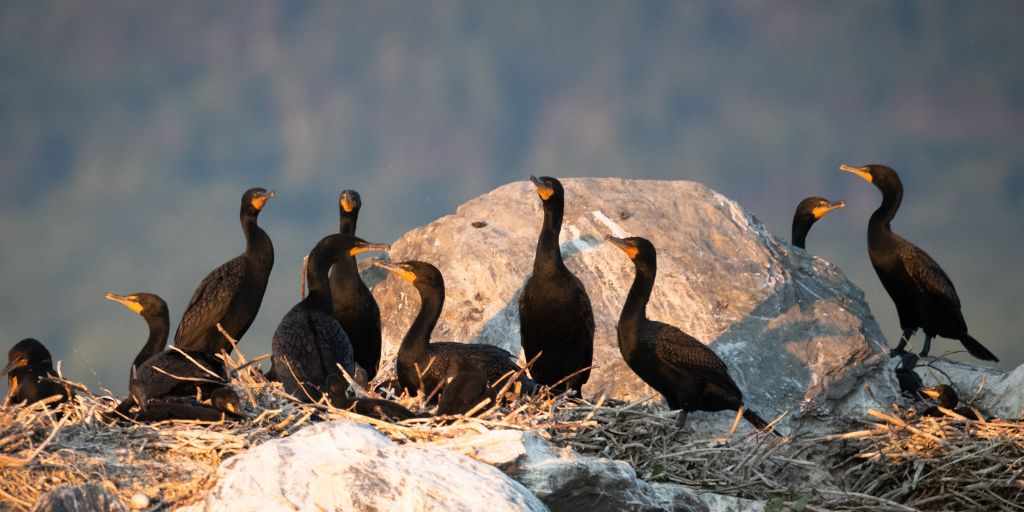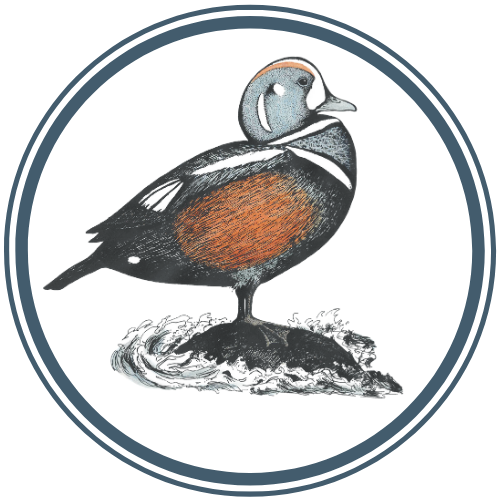Nature Notes: A Maine Naturalist Afield

Host: Logan Parker
Producer: Glen Mittelhauser
The search for mergansers continues and leads to lake isles crowded with colony nesting birds on Maine’s largest lake while subsequent efforts are dashed by fickle conditions.
Transcript
Nearly a month after a noteworthy encounter with a pair of Red-breasted Mergansers on Moosehead Lake, I had a chance to return to Northwest Cove. After a blustery morning, the lake was relatively still when I arrived in the early evening. Hoping the evening sun would better light my scanning efforts, I set out following the same track northward along the western shore. A Common Goldeneye hen nervously glided away from where her two young rested atop partly submerged stones, still sporting coats of gray down. As I neared the area where I had spotted the merganser pair in June, I paddled as slowly and silently as I could manage. Slight movements atop a shaded boulder caught my eye: a merganser hen! The look had been so brief and obscured that I couldn’t determine what species I had seen. The boulder sloped towards a small cove and faced away from my vantage. I’d only seen the top portion of the hen’s fringy head. She had also seen me, however, and I could hear her and what was surely a handful of peeping young descending towards cover. After a few minutes of searching, I located the birds along the shore and spotted the hen’s bright white chin patch. Common Merganser. As I paddled backwards, the birds retreated southward, one of the young birds hopping atop the hen’s back.
With only a few hours of daylight left at my disposal, I was determined to make the most of the trip. In the intervening weeks, I had read that Red-breasted Mergansers often nested on lake islands and so endeavored to reach one of the nearby islands before sunset would force my retreat. Scanning my surroundings and spotted a small, rocky landform rising from the water a mile distant–“Center Island” according to the map. Even from this distance, I could see that the island and surrounding waters were crowded with birds. This looked promising.
Center Island unlike any other lake island I’d ever visited. Were it not for the lack of salt air, I could almost have been convinced that I had been transported out to sea. Almost the entirety of the island’s barren land area had been fortified with heaps of driftwood, loosely woven into large, basket-like nests. The weavers were Double-crested Cormorants… nearly one hundred of them by my best estimate. The heads of gangly young swayed within the tangle of sticks while their proud parents perched on the rocks above like gargoyles with pumpkin-orange faces that practically glowed in the light of the low hanging sun. American Herring and Great Black-backed Gulls perched on the periphery. The skies above the island were noisy with the calls of Common Terns (Sterna hirundo). Although terns are often associated with the coast and ocean islands, these birds will nest on freshwater lakes in northern Maine. The terns made frequent visits to the island bearing small fish, landing and disappearing with their catch.
There were shorebirds here too. A handful of Spotted Sandpipers worked the water lapped rocks and, in their company, I spied a lone Semipalmated Sandpiper– the latter is, no doubt, a migrant stopped over on its journey from its sub-arctic breeding grounds. On a pebbly strand, just beyond the other shorebirds, a tall, slender Greater Yellowlegs strode. It, too, is a traveler, though not from so far to the north, breeding just north of the St. Lawrence. The presence of these birds is a reminder that the season is changing from the breeding season to the migratory period. Soon the woods and waters will be crowded with birds on the move to their non-breeding grounds. My time to search for breeding Red-breasted Mergansers could be running short. While I did spot a few mergansers near the island, as before, these were Common Mergansers. The terns’ opinion of me started to sour the longer I sat and scanned the island from my kayak and I heeded their requests to depart. With the sun beginning to pass behind the treed shoreline, I turned myself about and made for my launch site, again having been eluded by any possible Red-breasted Mergansers. However, I resolved that I would try again the next morning in another area of the cove. Yet, even the best of plans are so easily undone by unforeseen complications.
The next morning, I set out from Greenville, crossed the Moose River in Rockwood, and began the bumpy ride along 20-mile Road. About halfway along this rough, washboard passage to the north woods, I spotted something unexpected hovering just outside of my passenger window: my kayak. I pulled off and discovered that the car’s front crossbar had snapped and the kayak was now held only by the straining rear crossbar. I pieced together a temporary fix and limped the rest of the way at an even slower pace.
The delay had cost me. The winds had stirred earlier than expected. As I readied myself for a possible launch, a boat pulled up. A passenger hopped off to run after some lumber stacked on a nearby trailer while another steadied the wave sloshed boat at the shore. Striking up a conversation, I learned that the pair were carpenters working on a project out on the lake. I told them about my ongoing search for Red-breasted Mergansers and they shared that they had been seeing lots of Common Mergansers with young in the last few days. “It’s probably too rough for them out there today, though,” one of them said. “We don’t see them much when the winds kick up. It’s getting bad out there”.
A fresh check of the weather confirmed what was obvious from looking at the choppy lake surface and suggested that it wouldn’t be getting better any time soon. Foiled again. Scrapping my plans, I returned to stow my kayak in Greenville and then headed back to the north woods. Still, I was determined to return on a calmer day if such a day presented itself before the Atlas’ conclusion. Sure enough, one week later, I would find myself once again setting out into Northwest Cove with only a handful of days left in the 5 year long effort of the Maine Bird Atlas. This would be my final opportunity to attempt to locate and document the species within the state during this generation of the project.
The morning of my final attempt to search for Red-breasted Mergansers began with a pre-dawn ride up to Greenville. Picking up my kayak, I headed up to the northwest corner of the lake to spend one last morning searching. The day was off to a beautiful start and I felt optimistic as I set myself out onto the water. What followed was one of the most memorable and noteworthy days I’ve ever spent in the field.
Related Episodes
-

7/13/25: The Hunt for the Red-breasted Merganser, part 1
A noteworthy observation on Moosehead Lake sparks a determined effort to document one of Maine’s rarest breeding waterfowl.
-

7/27/25: The Hunt for the Red-breasted Merganser, part 3
The final opportunity to document breeding Red-breasted Mergansers arrives, but events take an unexpected turn with the shifting of…
-

8/3/25: The Hunt for the Red-breasted Merganser, part 4
After being temporarily stranded across Moosehead Lake’s Northwest Cove, Logan set out to Seboomook Island and the conclusion of…



